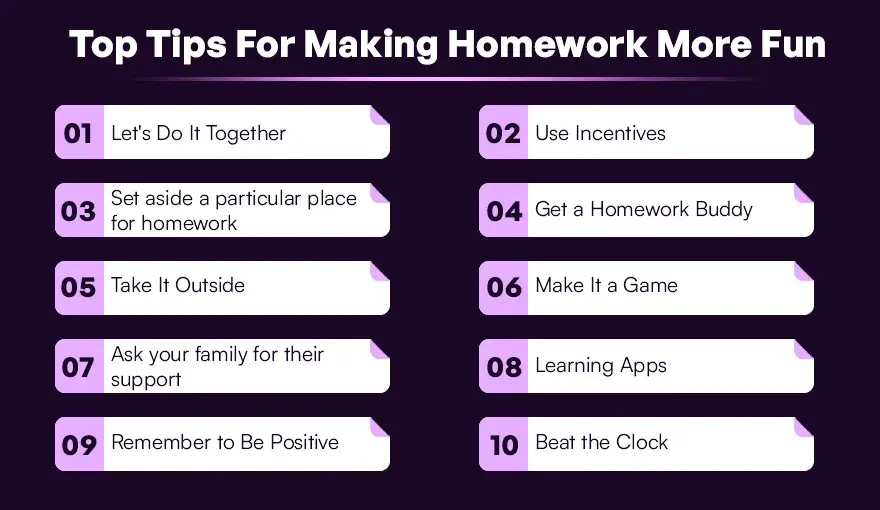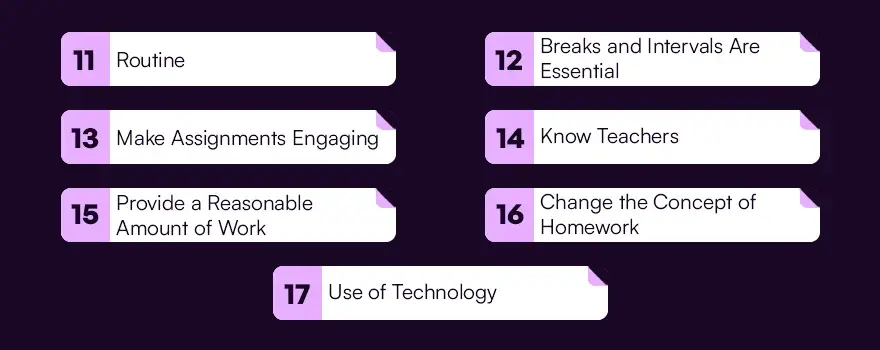17 Best Tips for Making Homework Fun

Kevin Gohil
Homework is one of the essential parts of a child's education; however, it does not have to be a chore. Creativity and structure can add right tools in order to make homework into a fun activity for students. This blog presents 17 actionable tips on how to make homework fun and encourage kids to stay motivated while developing a love for learning.
Quick Summary
Doing homework is boring for kids; however, through proper strategies, the whole process can be transformed into a fun and engaging activity. This blog shares 17 practical tips on how to use incentives, designing a space to do homework-friendly, gamify tasks, and lean technology for fun homework processing. These methods will help students have fun with learning while completing their assignments successfully.
Top Tips to Make Homework More Enjoyable
Make homework more enjoyable with these tips! Create a dedicated workspace, set achievable goals, add rewards, and turn learning into a game. Encourage breaks, use colorful tools, and stay involved to make study time fun and stress-free for kids and parents alike.

1. Let's Do It Together
When parents or siblings join, homework becomes a team effort. Sitting together while working on assignments allows kids to ask questions, share ideas, and feel supported. This goes well with the younger children because they require a nurturing environment.
2. Use Incentives
Incentives are great motivators. Therefore, if a reward is promised to them as soon as assignments are completed-in the form of extra playtime, a favorite snack, or an outing-they're motivated to do their work. Incentives make homework fun and teach goal-setting and discipline.
3. Set aside a particular place for homework
Having a dedicated space for studying helps students to focus. Make sure the space is warm, quiet, and provided with all the basic tools needed. Colorful decorations can personalize the space as well as make it warm and inviting for learning.
4. Get a Homework Buddy
Homework does not have to be overwhelming if the student has a friend or sibling to do it with. Cooperative work between children can stimulate ideas, problem-solve, and encourage each other. A homework buddy also brings in social stimulation for the process.
5. Take It Outside
A change of environment may be helpful in improving concentration. For example, homework can be taken to a park, backyard, or balcony for a welcome change in the environment. Fresh air and sunlight stimulate creativity and make an assignment less confining.
Also read this article : Best AI Apps For Homework Help
6. Make It a Game
Gamify homework by adding a little fun competition. For example, challenge them on something like solving a math problem in one minute or earning points on completing tasks. It makes the boring assignments quite an exciting activity and doesn't let kids get bored.
7. Ask your family for their support
Family members also can be a source of help and encouragement when children get stuck. Their contribution in helping with tough questions or explaining concepts relieves stress and instills self-confidence in them.
8. Learning Apps
Technology also provides various tools making homework more enjoyable. For instance, apps like Duolingo, Quizlet, or Kahoot! transform the learning process into entertaining games. Such platforms offer innovative ways of understanding concepts and, therefore, is a great solution for how to make homework enjoyable.
9. Remember to Be Positive
Appreciation and encouragement goes a long way in shaping how kids perceive homework. Positively talk about their strengths and the small things that bring them great triumphs. A positive attitude helps motivate students to come into school and tackle the tasks with eagerness.
10. Beat the Clock
Time-based challenges can be the thrill of assignments. Use a timer to set a particular duration of activities and invite children to do these things before the running of the timer. Running against the clock builds focus and adds fun.

11. Routine
Consistency builds productive habits. Designate a set time every day for homework so children can be aware of their schedule. With a routine schedule, there is less procrastination and less chance of going astray.
12. Breaks and Intervals Are Essential
Work can be overwhelming after long periods. Teach your children to take small breaks between tasks to clear their minds and recharge. Stretching, snacking, or a brief game can revive their concentration easily.
13. Make Assignments Engaging
Keep the homework interesting by relating it to daily examples, such as budgeting for grocery purposes to learn math or observation of plants to discuss the concepts. Curiosity and further understanding about subjects is encouraged when assignments are made interesting.
14. Know Teachers
The communication with teachers also helps keep parents and students posted on homework expectations. Teachers can usually offer suggestions on how to make hw fun by suggesting strategies personalized to the learning style of the child.
15. Provide a Reasonable Amount of Work
Overloading students with work makes them frustrated. Large tasks can be broken into smaller tasks, making the workload more manageable. The approach reduces stress, and kids remain motivated to work.
16. Change the Concept of Homework
Try changing the concept of homework as a boring task for this bright generation. Encourage them to think critically by developing presentations on various topics or give them practical work on projects. Make changes in their perceptions to increase the excitement.
17. Use of Technology
In addition to apps, technology presents interactive ways to the homework table. Virtual tutoring sites, educational videos, and virtual simulations are all interactive ways students can approach their homework. Using a gadget for interactive lessons keeps the kids on their toes.
Conclusion
The right mindset, tools, and creative strategy can make homework fun. Methods such as gamification, routine-making, and technology usage will keep a student engaged and make the learning process enjoyable. The focus will be on encouraging collaboration, breaks, and incentives that result in increasing productivity and motivation. Tools such as AssignmentGPT IO offer unique solutions aimed at simplifying more tasks and making studying an interactive activity. All these approaches bring homework to life for parents and instructors, making the activity more enjoyable and rewarding, but also encouraging a receptive attitude towards learning. This way, students can develop necessary skills for their educational journey and well beyond.
1. How to make homework fun for children?
Implement the excitement and interest by incorporating games, incentives, and breaks. You can also use learning apps with your family members for further support.
2. Which apps make homework fun?
Applications like Duolingo, Quizlet, and Kahoot! are useful, as they help in making learning an interactive and fun activity that motivates a child to be interested in homework.
3. How to help my child stay focused on homework?
Develop a routine, set up a study station, and create time challenges that help to improve focus and productivity.
4. What is homework break?
Breaks refresh the mind, help minimize stress, and improves one's focus; thus keeping kids motivated throughout a study session.
5. How does technology add fun to homework?
Technology has online availability of interactive tools including videos, virtual lessons, and even apps that use gamification to make learning exciting and fun.
Latest Blog's

AI Homework Helpers offer fast solutions, personalized learning, and round-the-clock study support for students in every subject.


Master exams with superior scores and less study time. Step-by-step tips using ChatGPT, Khanmigo, and Quizlet.


AI homework helpers streamline research, writing, and studying so students learn faster and complete assignments with less stress.


Master exams with superior scores and less study time. Step-by-step tips using ChatGPT, Khanmigo, Quizlet.


How deep learning makes AI homework helpers smarter, faster, and more personalized for students.


How AI homework helpers save time, boost learning, and provide personalized study support.

